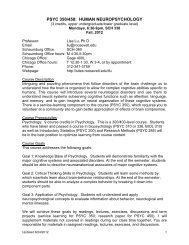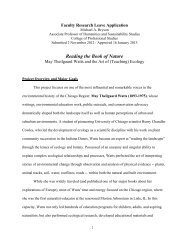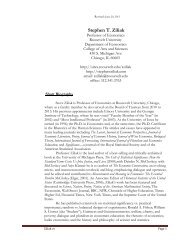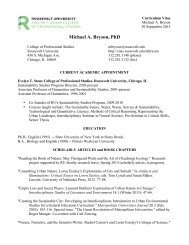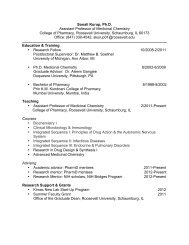Social Insurance and Public Assistance
public-assistance-welfare-reform-colonial-times-to-the-present-ziliak ...
public-assistance-welfare-reform-colonial-times-to-the-present-ziliak ...
Create successful ePaper yourself
Turn your PDF publications into a flip-book with our unique Google optimized e-Paper software.
POOR RELIEF Series Bf 34–149 727<br />
TABLE Bf 34–149 Paupers enumerated in almshouses, by region <strong>and</strong> state: 1880–1923 Continued<br />
East South Central<br />
Paupers enumerated per 100,000 population<br />
West South Central<br />
Total Kentucky Tennessee Alabama Mississippi Total Arkansas Louisiana Oklahoma Texas<br />
Bf128 Bf129 Bf130 Bf131 Bf132 Bf133 Bf134 Bf135 Bf136 Bf137<br />
Year Per 100,000 Per 100,000 Per 100,000 Per 100,000 Per 100,000 Per 100,000 Per 100,000 Per 100,000 Per 100,000 Per 100,000<br />
1880 60.2 82.9 73.7 40.7 30.5 9.4 13.1 — — 13.2<br />
1890 66.0 84.9 87.4 41.2 88.3 17.8 19.8 10.9 — 20.8<br />
1904 60.7 76.3 87.1 39.2 31.5 23.0 40.9 10.0 4.7 27.2<br />
1910 50.7 66.5 71.8 34.6 24.3 18.6 33.9 11.3 2.9 22.1<br />
1923 45.4 59.5 62.1 32.0 22.1 19.5 32.1 9.5 11.8 22.1<br />
Note appears at end of table<br />
(continued)<br />
Paupers enumerated per 100,000 population<br />
Mountain<br />
Total Montana Idaho Wyoming Colorado Arizona Utah Nevada Total Washington Oregon California<br />
Bf138 Bf139 Bf140 Bf141 Bf142 Bf143 Bf144 Bf145 Bf146 Bf147 Bf148 Bf149<br />
Year Per 100,000 Per 100,000 Per 100,000 Per 100,000 Per 100,000 Per 100,000 Per 100,000 Per 100,000 Per 100,000 Per 100,000 Per 100,000 Per 100,000<br />
1880 23.3 — 21.5 — 23.7 9.9 — 152.6 148.6 14.6 29.2 184.3<br />
1890 31.7 99.9 23.7 — 21.1 38.6 29.8 94.0 148.0 20.3 31.6 215.2<br />
1904 63.4 107.7 31.6 — 62.8 95.8 59.0 301.7 153.6 41.1 50.6 228.9<br />
1910 62.7 110.4 29.8 13 63.8 132.6 48.5 194.2 132.7 49.4 52.3 195.4<br />
1923 50.6 54.6 42.0 30 68.4 56.0 40.1 178.3 109.3 54.5 71.4 138.5<br />
Pacific<br />
1 Enumeration date June 1 through 1890; January 1 thereafter.<br />
Source<br />
Paupers in Almshouses: 1923 (U.S. Government Printing Office, 1926), Table<br />
4, p. 7. Notes for Table 4 appear in the report on pp. 1–5, 7.<br />
Documentation<br />
The data report the number of paupers in public almshouses only. The data<br />
do not report the number of paupers receiving relief in their own homes–<br />
those receiving “outdoor relief” – <strong>and</strong> they do not include the number of<br />
paupers residing in privately financed almshouses or asylums. Therefore, the<br />
data cannot be used as the only indicator of the extent of pauperism.<br />
Agreat store of statistical data on indoor institutions – almshouses, poorhouses,<br />
workhouses, insane asylums, <strong>and</strong> houses of refuge – can be found<br />
in the annual reports of the (variously named) State Boards of Charities <strong>and</strong><br />
Corrections, <strong>and</strong> in the county-level reports that comprise them. One may<br />
also find state <strong>and</strong> national information on the laws <strong>and</strong> practices of public<br />
assistance in the annual Proceedings of the National Conference of Charities <strong>and</strong><br />
Corrections.<br />
Although the word “pauper” slid away from American vocabularies for<br />
most of the twentieth century, the Bureau of the Census used the term during<br />
the first quarter of the twentieth century to categorize anyone who received<br />
public assistance. Prior to 1923, the Bureau of the Census took seven different<br />
censuses relating to paupers. A census of paupers was taken as a part of<br />
each decennial census from 1850 to 1880, while for 1904, 1910, <strong>and</strong> again<br />
for 1923, a special census of paupers in public almshouses was taken. The<br />
Bureau defined a public almshouse as an institution supported or controlled<br />
by town, municipal, county, or state authorities <strong>and</strong> used for the shelter of<br />
persons who are without means of self-support <strong>and</strong> who have no relatives<br />
able <strong>and</strong> willing or legally bound to aid them. The censuses of 1904, 1910,<br />
<strong>and</strong> 1923 included all public almshouses in the United States. The enumerations<br />
were made chiefly by officials of the institutions <strong>and</strong> covered not only<br />
the paupers who were inmates of almshouses on a given date but also those<br />
admitted in the course of one year <strong>and</strong> those who were discharged or transferred,<br />
or who died during one year.<br />
No almshouse was maintained in New Mexico in the years covered by<br />
this table.<br />
For a quantitative analysis of these pauper census data, see Stephen T.<br />
Ziliak, “By Foot, by Ford, by Horse, by Hearse: In <strong>and</strong> Out of America’s<br />
Almshouses, 1880–1923” (unpublished paper, Department of Economics,<br />
Bowling Green State University). A quantitative analysis of poorhouses in<br />
New York State may be found in Joan Underhill Hannon, “Shutting Down<br />
Welfare: Two Cases From America’s Past,” Quarterly Review of Economics <strong>and</strong><br />
Finance 37 (2) (1997): 419–38; Joan Underhill Hannon, “Poor Relief Policy<br />
in Antebellum New York State: The Rise <strong>and</strong> Decline of the Poorhouse,” Explorations<br />
in Economic History 22 (1985): 233–56; <strong>and</strong> Joan Underhill Hannon,<br />
“Poverty <strong>and</strong> the Antebellum Northeast: The View from New York State’s<br />
Poor Relief Rolls,” Journal of Economic History 44 (4) (1984): 1007–32. For a<br />
general introduction to the history of the almshouse, see David J. Rothman,<br />
The Discovery of the Asylum (Little, Brown, 1971), <strong>and</strong> Michael B. Katz, In the<br />
Shadow of the Poorhouse (Basic Books, 1986).



